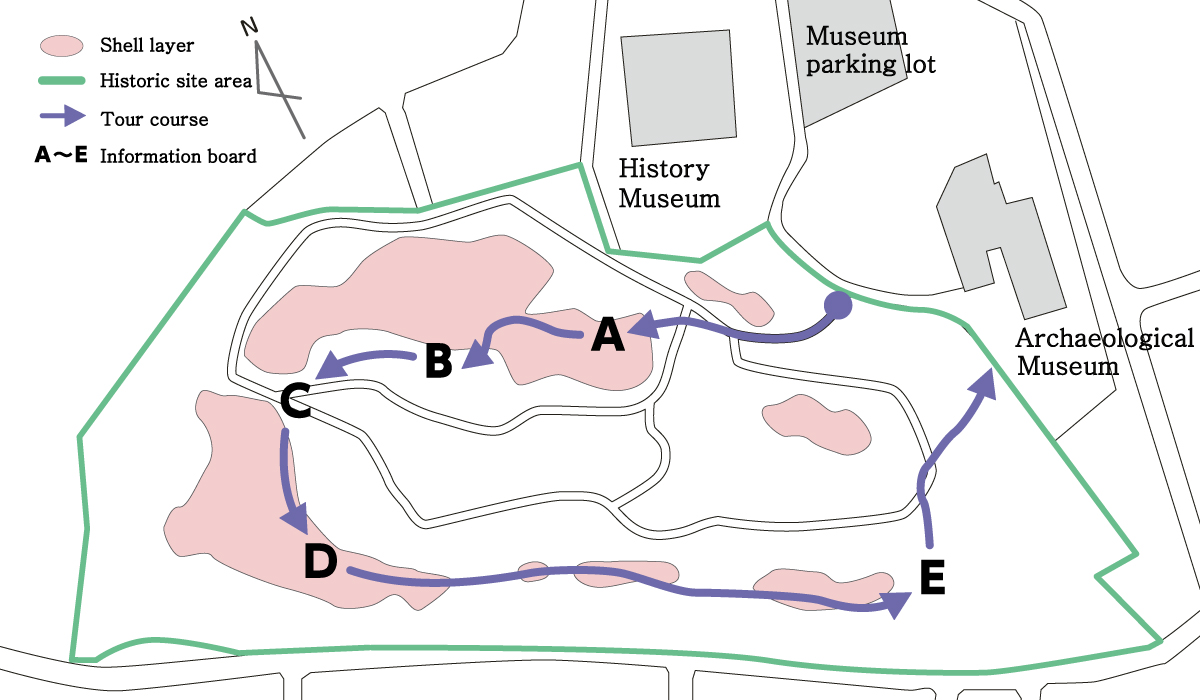
narration

Historians are uncertain about when humans first arrived in Japan from the Eurasian continent, but Paleolithic sites from tens of thousands of years ago have been found across the archipelago. The Horinouchi Shell Mound is an important archeological site that constitutes the remains of a settlement in the Horinouchi area of Ichikawa City. Dating from 4,000 to 2,500 years ago, it is one of the largest shell mounds discovered in Japan.
Despite their name, shell mounds do not consist entirely of shells. They usually contain various kinds of domestic waste, such as bones, stone flakes, and pottery sherds. In Japan, mounds like these are associated with Jōmon pottery, which is characterized by jōmon, or “rope patterns,” pressed into the clay. The Jōmon period (11,000–500 BCE) derives its name from the name of these patterns.
Between 4,000 and 2,500 years ago, the shore of Tokyo Bay was much closer to this site. The Horinouchi Shell Mound is situated on a plateau some 22 meters above flatlands east of the Edo River on the northeastern side of Tokyo Bay. The shell deposits are distributed over an area about 225 meters east–west and 120 meters north–south. In 1904, researchers from the Anthropological Society of Tokyo published their findings after excavating the area, making the site famous nationwide. During the 1904 excavation, the researchers discovered the first complete ancient human skeleton buried in Japan. In a 1949 excavation, Rikkyo University researchers unearthed a pit dwelling measuring 5 meters in diameter with a firepit in the center. The remains of the dwelling are thought to be roughly 3,700 years old and can still be viewed on the Horinouchi path. In 1954, archaeologists from Waseda University, Keio University, and Meiji University carried out further excavations and discovered that the shell deposits form the shape of a horseshoe that wraps around the promontory. In addition to traces of six dwellings, 13 sets of human remains have been unearthed here, suggesting that the people of Horinouchi buried their dead near their settlement. Objects that potentially held ceremonial or religious significance have also been found among the shells.
The Jōmon people were hunter-gatherers. The Horinouchi settlement was well situated because it provided easy access to seafood from the ocean and rivers—fish, shellfish, and cuttlefish—and to food from the mountains—nuts, berries, and wild game. When one food source was scarce, the inhabitants could turn to another, and this diversification improved their chances of survival. Based on the remains in the mounds, shellfish such as clams and sea snails were likely an important part of the inhabitants’ diet. They seem to have favored shellfish that had ample meat and were easy to harvest. Countless shells and shell fragments are visible along the path that winds through the site.
Jōmon people created many kinds of pottery, including bowls, deep pots with small necks, vessels with spouts, and pots shaped like morning glories. Despite their limited technology, potters in Horinouchi fashioned splendid vessels with ornate rims and spiral engravings. Outstanding examples of this pottery, as well as flints and other tools unearthed here, are on display in the Ichikawa City Archaeology Museum along with bone fragments and dioramas that depict life in the Jōmon period. Given the site’s proximity to Tokyo, it is one of the most-studied shell mounds in Japan, and similar pottery found elsewhere is called “Horinouchi-style pottery” after the first pieces discovered here.
The Horinouchi Shell Mound was part of a collection of settlements that formed an extended village. Gongenbara Shell Mound lies about 400 meters to the east of Horinouchi and contains similar traces of human settlement from around 4,000 to 3,700 years ago. In a valley to the south, another site has been excavated, revealing the remains of a wooden structure that was likely used to prepare chestnuts for consumption.

The Dirt Remembers:
Excavation of the Horinouchi Shell Mound
October 19, 1954
Hakozaki Kōtō
Photos and illustrations courtesy of: